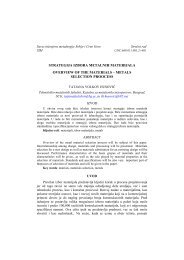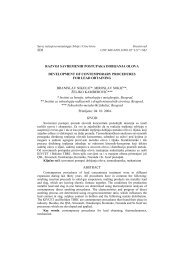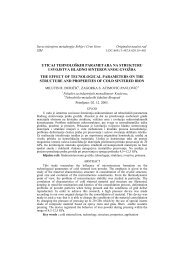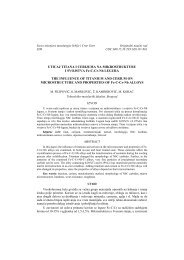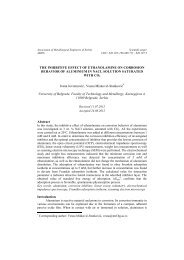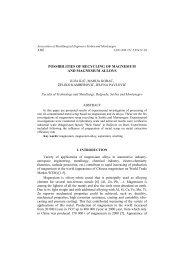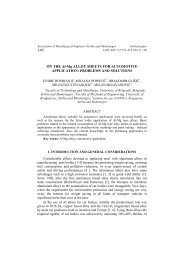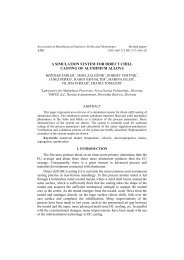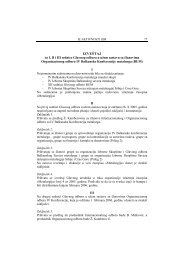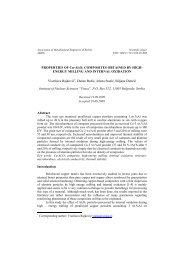STRUCTURAL CHARACTERISTICS OF SOME TERNARY Ag-In-Sn ...
STRUCTURAL CHARACTERISTICS OF SOME TERNARY Ag-In-Sn ...
STRUCTURAL CHARACTERISTICS OF SOME TERNARY Ag-In-Sn ...
Create successful ePaper yourself
Turn your PDF publications into a flip-book with our unique Google optimized e-Paper software.
162MJoM METALURGIJA - JOURNAL <strong>OF</strong> METALLURGY, 14, (3) 2008The <strong>In</strong>-<strong>Sn</strong> and <strong>Ag</strong>-<strong>Sn</strong> investigated solder alloys [2, 3] are already in practice, butonly in exactly determined conditions. Considering these, it could be expected that <strong>Ag</strong>-<strong>In</strong>-<strong>Sn</strong> ternary system might be one among proper substitutes for common solders.Thermodynamic characteristics and phase equilibria for the <strong>Ag</strong>-<strong>In</strong>-<strong>Sn</strong> system areinvestigated from various researchers.The element activities in the <strong>Ag</strong>-<strong>In</strong>-<strong>Sn</strong> system at 1273, 1373 and 1423 K, weredeterminated by T. Miki, N. Ogawa, T.Nagasaka and M.Hino [4] (mass spectrometry),and J. Zhang [5], (mass action law, at 1423 K).Phase equilibria for the system <strong>Sn</strong>-<strong>In</strong>-X (X=<strong>Ag</strong>, Bi, Zn, Sb) was investigated by I.Ohnuma, Y. Cui, J. Liu, et al. [6]. Using Thermo Calc software, the appropriatethermodynamic database was formed, and based on that, invariant reactions of thesystem, as well as isotermal sections at 373 and 473 K, were given in the paper. Also,the phase equilibria for the <strong>Sn</strong>-<strong>Ag</strong>-<strong>In</strong> system was obtained from experimental values(DSC and optical microscopy) and optimised binary data, by X. J. Liu, Y. <strong>In</strong>ohana, etal. from Japan, and Z. Moser, W. Gasior i J. Pstrus [7], from Poland.Based on large experimental work (optical microscopy, DSC, XRD, SEM,microhardness), <strong>Ag</strong>-<strong>In</strong>-<strong>Sn</strong> alloys were investigated by G.P. Vassilev et al. [8], and theisotermal section at 553 K was obtained.As a contribution to the better knowledge of the properties of mentioned system,the results of investigation of structural characteristics of some <strong>Ag</strong>-<strong>In</strong>-<strong>Sn</strong> alloys arepresented in this paper.EXPERIMENTALTwo sections (A and B) with constant molar ratio of <strong>In</strong>:<strong>Sn</strong> (1:4; 1:2), with 5samples from each section, were chosen from the concentration range of <strong>Ag</strong>-<strong>In</strong>-<strong>Sn</strong>system. The samples were with constant volume (0,3 cm 3 ) and with compositionsgiven in Table 1.Table 1. Composition of <strong>Ag</strong>-<strong>In</strong>-<strong>Sn</strong> alloys for different sectionssection X i %at %mass<strong>Ag</strong> <strong>In</strong> <strong>Sn</strong> <strong>Ag</strong> <strong>In</strong> <strong>Sn</strong> <strong>Ag</strong> <strong>In</strong> <strong>Sn</strong>0,1 0,18 0,72 10 18 72 9,221 17,679 73,100<strong>In</strong>:<strong>Sn</strong>=0,2 0,16 0,64 20 16 64 18,615 15,850 65,5351:40,3 0,14 0,56 30 14 56 28,166 13,990 57,844A0,4 0,12 0,48 40 12 48 37,885 12,097 50,0180,5 0,1 0,4 50 10 40 47,778 10,170 42,0520,1 0,300 0,600 10 30,0 60,0 9,258 29,583 61,159<strong>In</strong>:<strong>Sn</strong>= 0,2 0,267 0,533 20 26,7 53,3 18,681 26,543 54,7761:2 0,3 0,233 0,467 30 23,3 46,7 28,254 23,356 48,390B 0,4 0,200 0,400 40 20 40 37,988 20,216 41,7960,5 0,167 0,333 50 16,6 33,3 47,936 16,939 35,125




